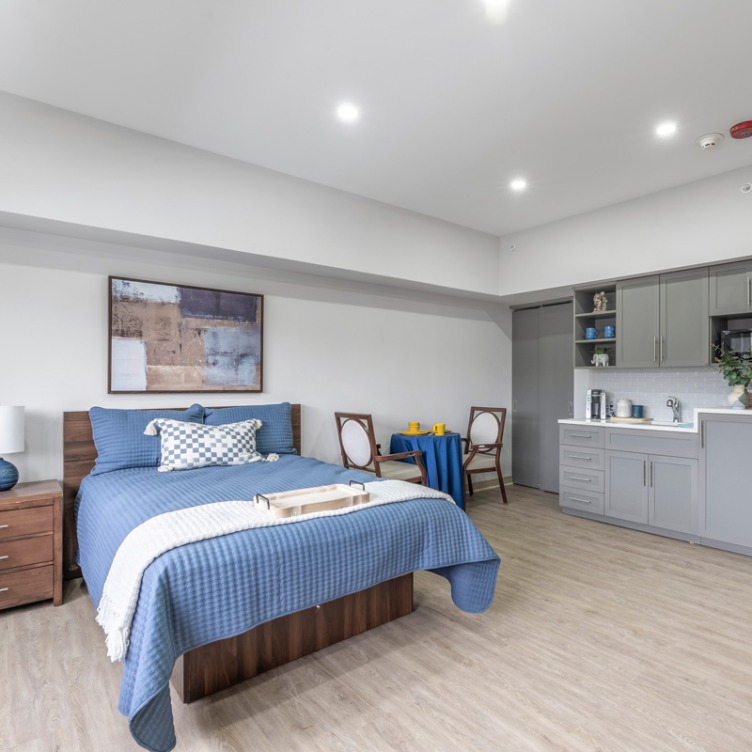Schedule Your Tour
The Cost of Assisted Living vs. In-Home Care
August 8, 2025Planning for senior care takes lots of work. You’ll need to consider your loved one’s health conditions, lifestyle choices, and where they’ll spend their golden years. For many families, the choice between assisted living and in-home care is one of the most important decisions they’ll make. While these levels of care have similar purposes, they certainly aren’t interchangeable. What’s more, they both come with a different price tag. Here’s what you need to know about in-home care vs. assisted living costs as you make this critical decision.

Pinning Down the Basics of Senior Care Options
Before we go any further, understanding the difference between assisted living and in-home health care is crucial. Assisted living is offered at dedicated residential facilities that provide housing, meals, and personal care services for seniors. Seniors in these communities need help with daily activities, but don’t require full-time medical supervision. Most of the time, residents live in private apartments with access to communal areas and 24/7 staff support.
In contrast to assisted living, home care takes place in your loved one’s current residence—no moving truck necessary. This option allows seniors to remain in a familiar environment while receiving personalized assistance with their daily activities. Care can range from a few hours per week to round-the-clock supervision, depending on individual needs.
The Cost of Assisted Living vs. In-Home Care
The end goal of assisted living and in-home care is the same: to create a safe, comfortable environment for older folks. However, these options each come with a list of costs. Every provider will have a different price tag, but here’s what you can expect from each.
Assisted Living Costs
The cost per month of assisted living varies greatly, with some sources estimating around $4,500 per month, and others reaching as high as $8,000. This drastic difference is due to several factors, including:
- Location—Geographic region plays a major role in pricing. States on the East Coast like Massachusetts tend to have higher costs, while states in the South and Midwest often offer more affordable options. The type of area matters, too—urban communities usually charge more for assisted living.
- Level of Care—Many assisted living communities offer several levels of care, including memory care or specialized services for certain conditions. If your loved one needs one of these services, they may incur a higher bill.
- Amenities—Upscale facilities with extensive amenities, gourmet dining, and premium accommodations cost significantly more than basic facilities.
- Room Type—Does your loved one prefer to live alone, or could they be interested in a roommate? You may be able to keep costs lower by opting for a shared living space rather than a private apartment.
In-Home Care Costs
Like the costs associated with assisted living, the price of in-home care varies. Non-medical home care could range from $20 to $30 per hour, while skilled nursing care can cost $50 to $80 per hour. Let’s take a look at what factors into the home health care cost:
- Number of Hours—How often will your loved one need care? Part-time care (20-30 hours weekly) costs significantly less than full-time care (40+ hours weekly). Live-in care, while more expensive overall, sometimes provides better value per hour.
- Type of Caregiver—Licensed nurses and certified nursing assistants usually cost more than companion caregivers or homemakers.
- Location—Similarly to assisted living, geographic location plays a role in pricing. Urban areas generally have higher hourly rates than rural communities.
Thinking Beyond the Bill: Non-Financial Considerations
It’s easy to get caught up in figuring out the total cost of senior care. But as you’re running the numbers, don’t forget to think about the non-financial aspect. Before you make a financial decision, make sure to consider the following:
Quality of Life
Beyond costs, consider how each option affects your loved one’s daily life. Assisted living provides social interaction, structured activities, and community engagement, which can combat isolation and depression. However, some seniors prefer the independence and familiarity of remaining in their own homes.
Family Involvement
In-home care often means greater family involvement in daily care decisions and more flexible visiting arrangements. Assisted living facilities sometimes have set visiting hours and policies that might limit time with family.
Medical Needs
Seniors with complex medical conditions often benefit from assisted living’s 24-hour staff availability and coordinated care approach. Although in-home care can provide more personalized attention, it may require more supervision from family members and additional coordination with healthcare providers.
Making the Right Decision for Your Family
There’s no single “right” answer when you’re weighing assisted living vs. home care. Every senior is different, but with careful consideration, you can help them make the best decision for their retirement years. At Courtyard Luxury Senior Living, we’re proud to serve so many seniors in Clinton, NJ and the surrounding areas. Our community provides a high standard of living and helps older folks find the comfort and convenience they deserve. Contact us today to learn more about joining our community.
